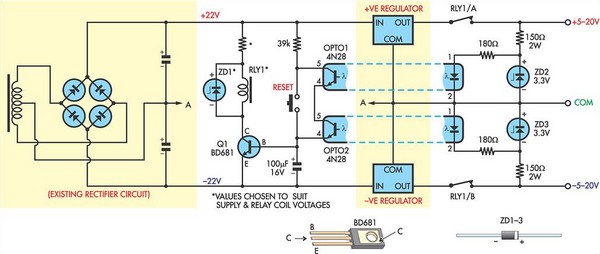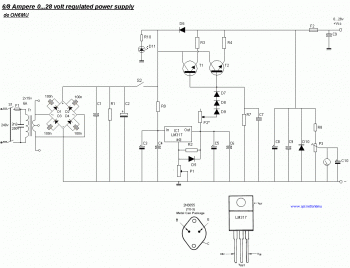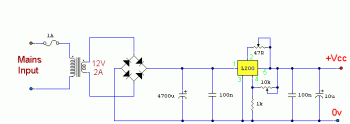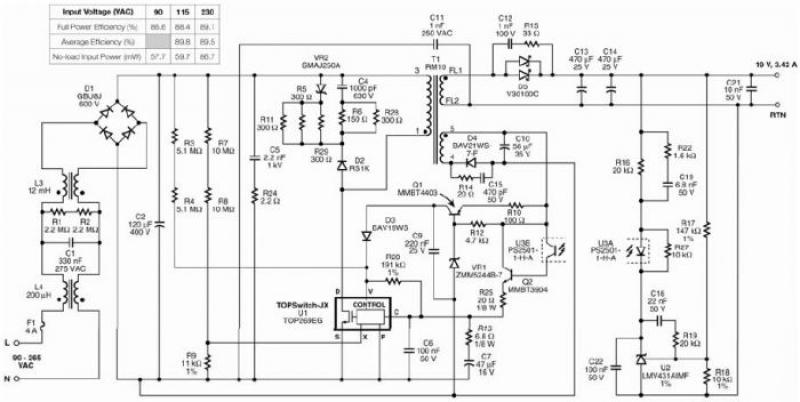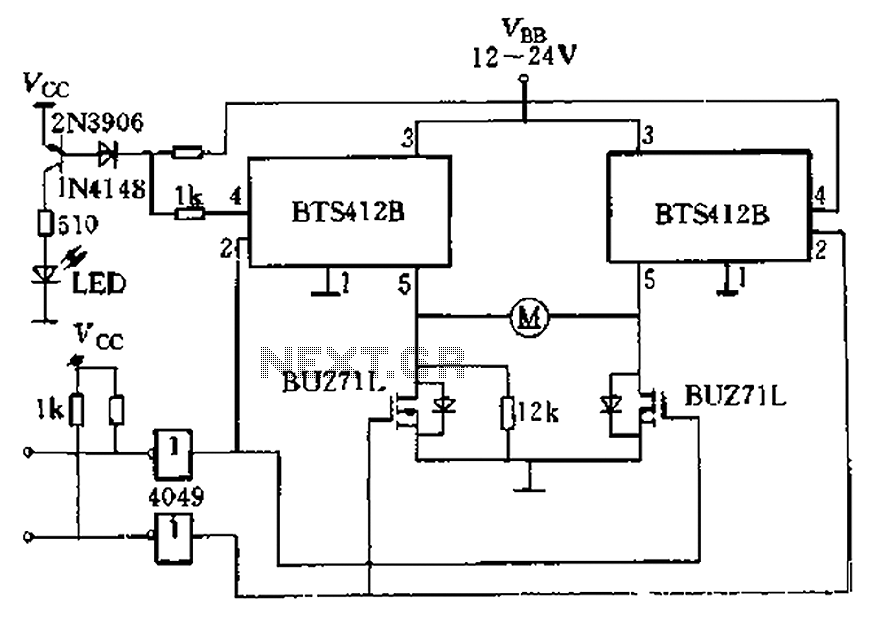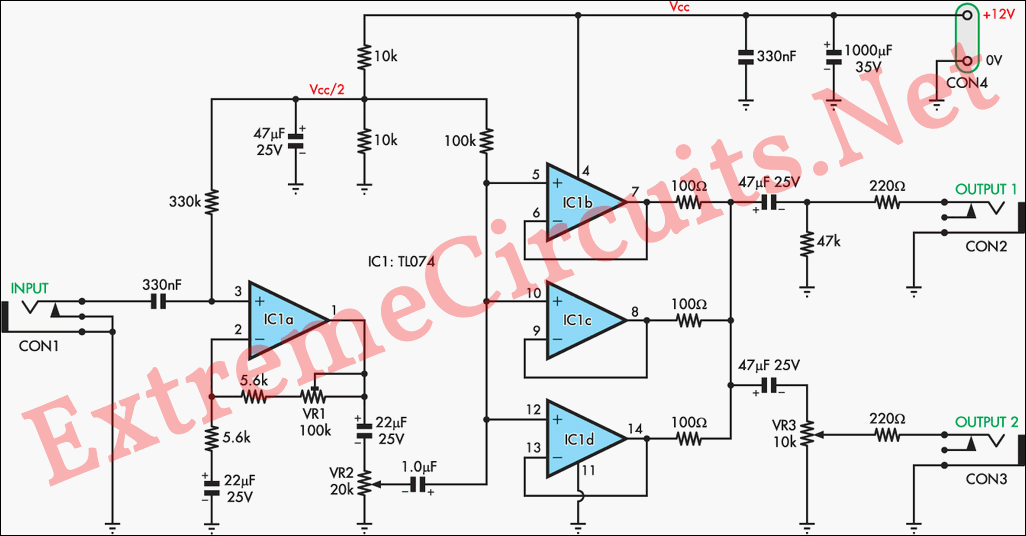
100W switching power amplifier circuit
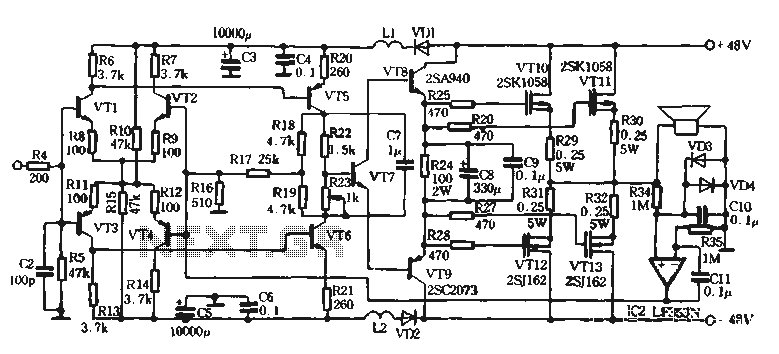
The self-designed amplifier circuit described is completely symmetrical and complementary, effectively utilizing the advantages of complementary NPN and PNP transistors to achieve a high degree of stability. The circuit features good symmetry in the push-pull amplification state, allowing for high-fidelity signal transmission without the need for coupling capacitors or large loop negative feedback. This design transforms the circuit into a DC amplifier, eliminating phase shift issues caused by capacitors. It reduces intermodulation distortion and vibrations generated by the speaker's voice coil, significantly improving the overall conversion rate of the circuit. The input stage consists of a differential amplifier formed by transistors VT1 to VT4, which does not employ a conventional constant current circuit but instead utilizes a long tail circuit. The amplifier operates with a high-frequency switching power supply, which contributes positively to the stability of the operating point. Each set of differential amplifier quiescent current is maintained at 1 mA, ensuring an appropriate increase in the signal-to-noise ratio, with a total quiescent current of 6 mA for this stage. Negative feedback is provided from the collectors of VT6 and VT5 through resistors R18, R19, R17, and R16, forming a DC negative feedback loop that determines the amplification factor. The output stage, composed of transistors VT8 and VT9, delivers ample current output, enhancing the circuit's ability to follow instantaneous signals and ensuring a substantial dynamic output with a static quiescent current of 32 mA. This design addresses transient large signal output issues. The current level is also related to tone quality. The final output circuit employs Hitachi ZSK10582SJ162 tubes, which provide warm tones and detailed sound characteristics. Each channel includes two pairs of parallel components, with resistors R25 to R28 serving as vibration absorption resistors, while capacitors C8 and C9 stabilize the quiescent current bias, adjusted to 480 mA, allowing the circuit to operate in class AB mode. The design incorporates temperature compensation through VT7, considering the pairing of precision transistors, with a midpoint potential servo composed by IC2. Diodes VD1 and VD2 are included to prevent mutual interference between the front and output stages, and a high-frequency pulse power supply is utilized to mitigate issues caused by the input stage. The front stage filter capacitors C3 to C5 are of larger capacity, enhancing their effectiveness.
The amplifier circuit is designed to maximize audio performance while minimizing distortion and phase shift. The symmetrical and complementary design of the NPN and PNP transistors ensures that both halves of the audio signal are amplified equally, which is crucial for maintaining audio fidelity. By eliminating coupling capacitors, the circuit avoids potential phase shifts that can degrade sound quality, particularly in high-frequency ranges.
The differential amplifier stage, using a long tail configuration, allows for better signal processing and noise reduction compared to traditional designs. The quiescent current settings are critical; they establish a baseline operational state that optimizes signal-to-noise ratios while preventing thermal runaway in the transistors. The feedback network is carefully designed to provide stability across varying loads and input signals, ensuring that the amplifier can handle dynamic audio without distortion.
The output stage's use of high-quality tubes enhances the overall sound character, providing warmth and detail that are often sought after in high-fidelity audio applications. The careful selection of components, including the use of vibration absorption resistors and stabilizing capacitors, contributes to the circuit's robustness and reliability.
In summary, this amplifier circuit exemplifies advanced audio engineering principles, focusing on symmetry, stability, and fidelity, making it suitable for high-performance audio applications. The design considerations and component choices reflect a deep understanding of the interplay between electronic components and audio signal integrity.Self-designed amplifier circuit 9 of the circuit described in this article is completely symmetrical and complementary, can give full play to the advantages of complementary NPN and PNP transistors, so that the whole circuit has a very high degree of stability. Because the signal from input to output at the push-pull amplification state so good symmetry, temple high fidelity circuit signal path without a coupling capacitor homes, no large loop negative feedback.
The circuit becomes a DC amplifier circuit to eradicate the capacitor caused by the presence of dye tone phase shift. Reduced due to large transient counter electromotive force when the depth of the negative feedback loop caused by intermodulation distortion and vibration generated by the speaker voice coil of the front portion of the circuit interference.
So that the conversion rate of the entire circuit is greatly improved. The resolution of a strong small-signal q VT1 ~ VT4 composed of a differential amplifier input stage circuit. The class does not use conventional constant current circuit Henan, while the use of long tail circuits.
Amplifier uses high-frequency switching power supply, stable operating point of the circuit has played a positive role in this 6. Not only simplifies the circuit and make the actual audition t improve sound quality also confirms this.
Each set of differential amplifier quiescent current of ImA, proved in ensuring the premise of an appropriate increase in signal to noise ratio required for this level of input current, this stage quiescent current is 6mA. Negative feedback from the VT6, VT5 collector by R18, R19, R17, R16 leads connected to the input stage of the inverting input interface circuit forming a DC negative feedback magnification by the (R, B R.
ga + R17) / R] 5 decision. Circuit driven by the level VT8.VT9 composition, there is plenty of current output and improve followability instantaneous signal to ensure a large dynamic output, the level static take-state current 32mA, thus improving transient large signal output powerless ills. In addition the size of the current level and tone related. Final output circuit using Hitachi ZSK10582SJ162 sound field effect on the tube, to whichever warm tone, detail the advantages and strong.
Each channel two pairs of parallel, each gate of the string of R25 ~ R28 resistance vibration absorption resistance, the parallel C8. C9 capacitors role is to stabilize the quiescent current bias 6 per tube was adjusted to 480mA, working in class AB mouth due to the current level to promote crystal transistor having a positive temperature coefficient t work when a certain temperature, it is for the installation of a temperature compensation VT7 application taking into account the conditions of the amateur pairing precision transistors, using the midpoint potential servo composed by the lC2 circuit.
Circuit VD1, VD2 is separated to prevent mutual interference from before and after class and added, high-frequency pulse power supply 11 1.2 is only caused by the eye into the front stage and setting. Front -stage filter capacitor C3-cs larger capacity, have a good effect q
The amplifier circuit is designed to maximize audio performance while minimizing distortion and phase shift. The symmetrical and complementary design of the NPN and PNP transistors ensures that both halves of the audio signal are amplified equally, which is crucial for maintaining audio fidelity. By eliminating coupling capacitors, the circuit avoids potential phase shifts that can degrade sound quality, particularly in high-frequency ranges.
The differential amplifier stage, using a long tail configuration, allows for better signal processing and noise reduction compared to traditional designs. The quiescent current settings are critical; they establish a baseline operational state that optimizes signal-to-noise ratios while preventing thermal runaway in the transistors. The feedback network is carefully designed to provide stability across varying loads and input signals, ensuring that the amplifier can handle dynamic audio without distortion.
The output stage's use of high-quality tubes enhances the overall sound character, providing warmth and detail that are often sought after in high-fidelity audio applications. The careful selection of components, including the use of vibration absorption resistors and stabilizing capacitors, contributes to the circuit's robustness and reliability.
In summary, this amplifier circuit exemplifies advanced audio engineering principles, focusing on symmetry, stability, and fidelity, making it suitable for high-performance audio applications. The design considerations and component choices reflect a deep understanding of the interplay between electronic components and audio signal integrity.Self-designed amplifier circuit 9 of the circuit described in this article is completely symmetrical and complementary, can give full play to the advantages of complementary NPN and PNP transistors, so that the whole circuit has a very high degree of stability. Because the signal from input to output at the push-pull amplification state so good symmetry, temple high fidelity circuit signal path without a coupling capacitor homes, no large loop negative feedback.
The circuit becomes a DC amplifier circuit to eradicate the capacitor caused by the presence of dye tone phase shift. Reduced due to large transient counter electromotive force when the depth of the negative feedback loop caused by intermodulation distortion and vibration generated by the speaker voice coil of the front portion of the circuit interference.
So that the conversion rate of the entire circuit is greatly improved. The resolution of a strong small-signal q VT1 ~ VT4 composed of a differential amplifier input stage circuit. The class does not use conventional constant current circuit Henan, while the use of long tail circuits.
Amplifier uses high-frequency switching power supply, stable operating point of the circuit has played a positive role in this 6. Not only simplifies the circuit and make the actual audition t improve sound quality also confirms this.
Each set of differential amplifier quiescent current of ImA, proved in ensuring the premise of an appropriate increase in signal to noise ratio required for this level of input current, this stage quiescent current is 6mA. Negative feedback from the VT6, VT5 collector by R18, R19, R17, R16 leads connected to the input stage of the inverting input interface circuit forming a DC negative feedback magnification by the (R, B R.
ga + R17) / R] 5 decision. Circuit driven by the level VT8.VT9 composition, there is plenty of current output and improve followability instantaneous signal to ensure a large dynamic output, the level static take-state current 32mA, thus improving transient large signal output powerless ills. In addition the size of the current level and tone related. Final output circuit using Hitachi ZSK10582SJ162 sound field effect on the tube, to whichever warm tone, detail the advantages and strong.
Each channel two pairs of parallel, each gate of the string of R25 ~ R28 resistance vibration absorption resistance, the parallel C8. C9 capacitors role is to stabilize the quiescent current bias 6 per tube was adjusted to 480mA, working in class AB mouth due to the current level to promote crystal transistor having a positive temperature coefficient t work when a certain temperature, it is for the installation of a temperature compensation VT7 application taking into account the conditions of the amateur pairing precision transistors, using the midpoint potential servo composed by the lC2 circuit.
Circuit VD1, VD2 is separated to prevent mutual interference from before and after class and added, high-frequency pulse power supply 11 1.2 is only caused by the eye into the front stage and setting. Front -stage filter capacitor C3-cs larger capacity, have a good effect q
Warning: include(partials/cookie-banner.php): Failed to open stream: Permission denied in /var/www/html/nextgr/view-circuit.php on line 713
Warning: include(): Failed opening 'partials/cookie-banner.php' for inclusion (include_path='.:/usr/share/php') in /var/www/html/nextgr/view-circuit.php on line 713
